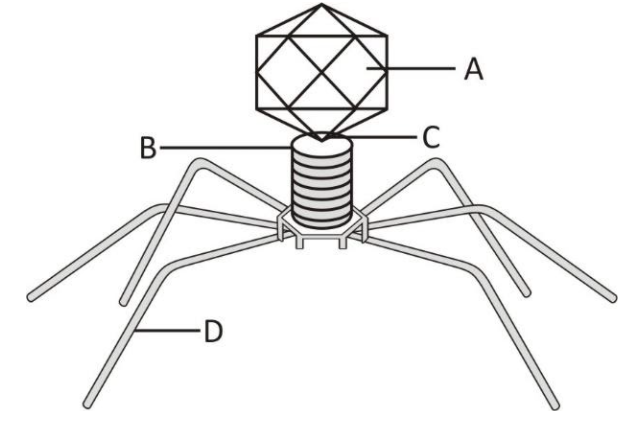
Given above is a diagram of bacteriophage. In which one of the opinions of all the four parts A, B, C, and D are correct?
A B C D 1. Collar Tail fibres Head Sheath 2. Tail fibres Head Sheath Collar 3. Sheath Collar Head Tail fibres 4. Head Sheath Collar Tail fibres

A. 1
B. 2
C. 3
D. 4
| A | B | C | D | |
| 1. | Collar | Tail fibres | Head | Sheath |
| 2. | Tail fibres | Head | Sheath | Collar |
| 3. | Sheath | Collar | Head | Tail fibres |
| 4. | Head | Sheath | Collar | Tail fibres |

Answer
564k+ views
Hint: A bacteriophage is a bacteria-eating virus, these viruses are endoparasites of bacteria, use their host to replicate and then destroy their host cells. A bacteriophage is a type of virus or an envelope of protein that has genetic material such as DNA or RNA in it. These are used in genetic engineering as cloning vectors.
Complete answer:
The structural components of bacteriophages can be understood by comparing it with the human body. As we move upside down, the uppermost part is the head, then comes the neck. The tail remains covered by the sheath so the darkened part is the sheath. The last part is the tail fibres.
So, option D i.e ‘4’ is the correct answer.
Additional information:
- The head of the bacteriophage is also called a capsid. It encapsulates the genetic material in it. The function of the capsid envelope is to protect the genetic material from the outer environment.
- The neck or the collar act as the joint between the head and the tail. The collar also acts as environment-sensing devices.
- The tail is a hollow tube that serves as a passageway for the genetic material to pass from the capsid to the host bacteria.
- The collar and whiskers are environment-sensing devices. The tail fibres help in the interaction and the attachment of the virus to the host cell.
Note: A virus is a non-living cell that needs a host to replicate or to reproduce. Primarily bacteriophages can be classified into two categories- lytic bacteriophages and temperate bacteriophages.
Complete answer:
The structural components of bacteriophages can be understood by comparing it with the human body. As we move upside down, the uppermost part is the head, then comes the neck. The tail remains covered by the sheath so the darkened part is the sheath. The last part is the tail fibres.
So, option D i.e ‘4’ is the correct answer.
Additional information:
- The head of the bacteriophage is also called a capsid. It encapsulates the genetic material in it. The function of the capsid envelope is to protect the genetic material from the outer environment.
- The neck or the collar act as the joint between the head and the tail. The collar also acts as environment-sensing devices.
- The tail is a hollow tube that serves as a passageway for the genetic material to pass from the capsid to the host bacteria.
- The collar and whiskers are environment-sensing devices. The tail fibres help in the interaction and the attachment of the virus to the host cell.
Note: A virus is a non-living cell that needs a host to replicate or to reproduce. Primarily bacteriophages can be classified into two categories- lytic bacteriophages and temperate bacteriophages.
Recently Updated Pages
Master Class 11 Economics: Engaging Questions & Answers for Success

Master Class 11 English: Engaging Questions & Answers for Success

Master Class 11 Social Science: Engaging Questions & Answers for Success

Master Class 11 Biology: Engaging Questions & Answers for Success

Class 11 Question and Answer - Your Ultimate Solutions Guide

Master Class 11 Business Studies: Engaging Questions & Answers for Success

Trending doubts
What is meant by exothermic and endothermic reactions class 11 chemistry CBSE

10 examples of friction in our daily life

One Metric ton is equal to kg A 10000 B 1000 C 100 class 11 physics CBSE

Difference Between Prokaryotic Cells and Eukaryotic Cells

What are Quantum numbers Explain the quantum number class 11 chemistry CBSE

1 Quintal is equal to a 110 kg b 10 kg c 100kg d 1000 class 11 physics CBSE




